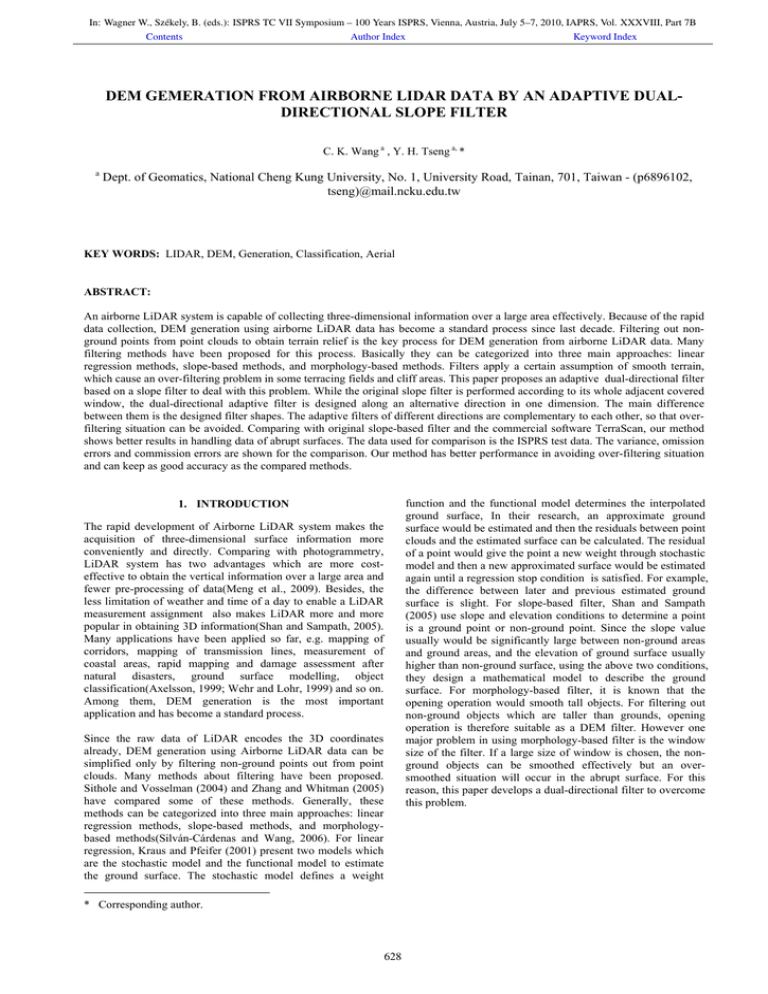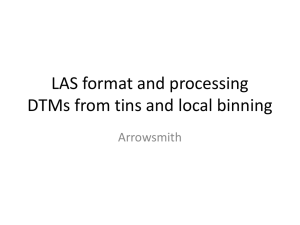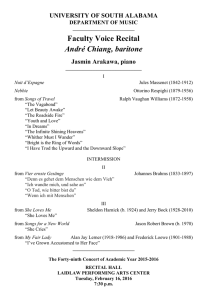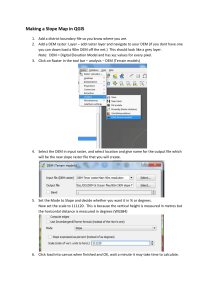DEM GEMERATION FROM AIRBORNE LIDAR DATA BY AN ADAPTIVE DUAL-
advertisement

In: Wagner W., Székely, B. (eds.): ISPRS TC VII Symposium – 100 Years ISPRS, Vienna, Austria, July 5–7, 2010, IAPRS, Vol. XXXVIII, Part 7B Contents Author Index Keyword Index DEM GEMERATION FROM AIRBORNE LIDAR DATA BY AN ADAPTIVE DUALDIRECTIONAL SLOPE FILTER C. K. Wang a , Y. H. Tseng a, * a Dept. of Geomatics, National Cheng Kung University, No. 1, University Road, Tainan, 701, Taiwan - (p6896102, tseng)@mail.ncku.edu.tw KEY WORDS: LIDAR, DEM, Generation, Classification, Aerial ABSTRACT: An airborne LiDAR system is capable of collecting three-dimensional information over a large area effectively. Because of the rapid data collection, DEM generation using airborne LiDAR data has become a standard process since last decade. Filtering out nonground points from point clouds to obtain terrain relief is the key process for DEM generation from airborne LiDAR data. Many filtering methods have been proposed for this process. Basically they can be categorized into three main approaches: linear regression methods, slope-based methods, and morphology-based methods. Filters apply a certain assumption of smooth terrain, which cause an over-filtering problem in some terracing fields and cliff areas. This paper proposes an adaptive dual-directional filter based on a slope filter to deal with this problem. While the original slope filter is performed according to its whole adjacent covered window, the dual-directional adaptive filter is designed along an alternative direction in one dimension. The main difference between them is the designed filter shapes. The adaptive filters of different directions are complementary to each other, so that overfiltering situation can be avoided. Comparing with original slope-based filter and the commercial software TerraScan, our method shows better results in handling data of abrupt surfaces. The data used for comparison is the ISPRS test data. The variance, omission errors and commission errors are shown for the comparison. Our method has better performance in avoiding over-filtering situation and can keep as good accuracy as the compared methods. function and the functional model determines the interpolated ground surface, In their research, an approximate ground surface would be estimated and then the residuals between point clouds and the estimated surface can be calculated. The residual of a point would give the point a new weight through stochastic model and then a new approximated surface would be estimated again until a regression stop condition is satisfied. For example, the difference between later and previous estimated ground surface is slight. For slope-based filter, Shan and Sampath (2005) use slope and elevation conditions to determine a point is a ground point or non-ground point. Since the slope value usually would be significantly large between non-ground areas and ground areas, and the elevation of ground surface usually higher than non-ground surface, using the above two conditions, they design a mathematical model to describe the ground surface. For morphology-based filter, it is known that the opening operation would smooth tall objects. For filtering out non-ground objects which are taller than grounds, opening operation is therefore suitable as a DEM filter. However one major problem in using morphology-based filter is the window size of the filter. If a large size of window is chosen, the nonground objects can be smoothed effectively but an oversmoothed situation will occur in the abrupt surface. For this reason, this paper develops a dual-directional filter to overcome this problem. 1. INTRODUCTION The rapid development of Airborne LiDAR system makes the acquisition of three-dimensional surface information more conveniently and directly. Comparing with photogrammetry, LiDAR system has two advantages which are more costeffective to obtain the vertical information over a large area and fewer pre-processing of data(Meng et al., 2009). Besides, the less limitation of weather and time of a day to enable a LiDAR measurement assignment also makes LiDAR more and more popular in obtaining 3D information(Shan and Sampath, 2005). Many applications have been applied so far, e.g. mapping of corridors, mapping of transmission lines, measurement of coastal areas, rapid mapping and damage assessment after natural disasters, ground surface modelling, object classification(Axelsson, 1999; Wehr and Lohr, 1999) and so on. Among them, DEM generation is the most important application and has become a standard process. Since the raw data of LiDAR encodes the 3D coordinates already, DEM generation using Airborne LiDAR data can be simplified only by filtering non-ground points out from point clouds. Many methods about filtering have been proposed. Sithole and Vosselman (2004) and Zhang and Whitman (2005) have compared some of these methods. Generally, these methods can be categorized into three main approaches: linear regression methods, slope-based methods, and morphologybased methods(Silván-Cárdenas and Wang, 2006). For linear regression, Kraus and Pfeifer (2001) present two models which are the stochastic model and the functional model to estimate the ground surface. The stochastic model defines a weight * Corresponding author. 628 In: Wagner W., Székely, B. (eds.): ISPRS TC VII Symposium – 100 Years ISPRS, Vienna, Austria, July 5–7, 2010, IAPRS, Vol. XXXVIII, Part 7B Contents Author Index Keyword Index with along forward and backward, it is called dual-directional in this paper. 2. DUAL DIRECTIONAL SLOPE-BASED FILTER 2.1 Slope-Based Filter break line The slope-based filter was firstly proposed by Vosselman (2000). This filter is designed by a kernel function which is composed of two parameters, slope and searching scope( d ), expressed in eq. (1). (a) diagram of adaptive-slope filtering k (x, y ) h m ax (1) ( d ) slo p e d break line Figure 1 shows the diagram of the kernel function and indicates the principle of filtering. The cone-like searching window is determined by the kernel function. To decide a measured point is a ground point or not, the algorithm checks any other points locate under the cone window. If yes, the point will be labelled as a non-ground point, or it is labelled as a ground point. (b) diagram of over-filtering near break line break line (c) unwanted smoothed areas due to over-filtering Searching Scope d hmax (d ) pi Figure 2. Diagram of over-filtering slope slope(s) slope hmax / d searching scope(l) Figure 1. Diagram of a kernel function It is obvious that the slope threshold should be properly determined based on the terrain type. An adaptive slope-based filter(ASF)(Sithole, 2001; Tseng et al., 2004) is therefore designed to determine the slope threshold before running the slope-based filter. Figure 3. Diagram of dual-directional slope-based filter The adaptive slope-based filter work well either for a flat surface or an oblique surface. However, areas near terracing fields and cliff areas may result in unreliable estimation of slope. Classification errors would occur in this kind of areas. Figure 2 indicates an unwanted filtering situation. Figure 2(a) shows the filtering processing using an adaptive slope-based filter and some points near the break line would be eliminated. This situation is called over-filtering and the missing points will result in a smoother DEM than the true DEM(Figure 2(c)). (a) Diagram of point clouds 2.2 Dual Directional Slope-Based Filter To overcome over-filtering, a dual-directional adaptive slopebased filter(DDASF) is presented in this paper. The basic idea is to divide original filter into two filters(see Figure 3). If we reconsider the over-filtering problem and perform the two filters, the missing points will be retained in the filtering result by alternative one of the two filters (see Figure 4(b)). The final filtering result can be the union of the two results. In other words, any point which as long as passes one of the two filters will be labelled as a ground point. Since the shape of ASF is symmetric, ASF is non-directional. The filtering results will be the same if we rotate ASF. However DDASF is designed to deal (b) filtering results of DDASF (c) Union of the two filtering results Figure 4. Diagram of DDASF filtering 629 In: Wagner W., Székely, B. (eds.): ISPRS TC VII Symposium – 100 Years ISPRS, Vienna, Austria, July 5–7, 2010, IAPRS, Vol. XXXVIII, Part 7B Contents Author Index The shape of DDASF is determined by the two parameters, slope( s ) and searching scope( l ). The slope can be estimated by adjacent points and the searching scope can be determined by the biggest size of objects in the landscape. If l is not big enough, a tall and big object may remain some non-ground points near the break line which is shown as Figure 5. Keyword Index Raw LiDAR data Initial ground surface Rough filtering Outlier removing and structuration DDASF ground points (a) Diagram of point clouds Yes DX = DX/2 If (DX >= dx) No DEM (b) filtering results of DDASF Figure 6. Flow chart of DEM generation by DDASF 3. EXPERIMENTS AND ANALYSES (c) some non-ground points are remained after the union of the two filtering results Three DEM generation methods were compared. One is the adaptive slope-based filter(ASF) developed by Tseng, et al.(2004). The second one is using the commercial software, TerraScan. The last is our developed method. The LiDAR data used in this experiment is provided by ISPRS Commission III (http://www.itc.nl/isprswgIII-3/filtertest/index.html). Fifteen samples chosen as reference data are generated by manual filtering. To test the effectiveness of filtering in terracing fields and cliff areas by DDASF, Sample 23 and Sample 53 are chosen because disconnected terrain exists in both data. Figure 5. Filtering errors resulted from insufficient searching scope 2.3 Procedure of DEM generation by DDASF The flow chart of DDASF is shown in Figure 6. Firstly the outliers of LiDAR point cloud are removed. Normally they are extremely higher or lower than adjacent points and isolated from other points. The outliers can be removed from raw LiDAR data using the above conditions, the remaining points are then structured for constructing a spatial relationship between points. Triangle irregular network and regular voxels are both common methods to structure scattered points. In this paper, the regular voxel is used. The complete scattered spatial is divided into voxels of the same size. DX , DZ denote the length and height of a voxel respectively. Since the ground points are normally located on lower voxels, the lowest voxels which contain at least one point are searched. The initial ground surface can be therefore obtained by those points contained in the lowest voxels. Once the initial ground surface is determined, the local plane of a voxel is calculated with its adjacent voxels. The rough filter refers to remove the points which exceed a threshold from the local plane to its position. The remaining points are again filtered by DDASF. And then the procedure iterates until a condition is satisfied. The final output is therefore used to generate DEM. (a) sample 23 (a) sample 53 Figure 7. Test data 3.1 Filtering results of Sample 23 Sample 23 is located at urban areas. The buildings are complex, large and some of them are even connected. The lower left of 630 In: Wagner W., Székely, B. (eds.): ISPRS TC VII Symposium – 100 Years ISPRS, Vienna, Austria, July 5–7, 2010, IAPRS, Vol. XXXVIII, Part 7B Contents Author Index Keyword Index the landscape shows a disconnected area. Figure 8 (a)~(d) show the reference DEM and the filtered DEM by three filters respectively. We can see that the erosions and smoothness were produced at the disconnected areas which generated by TerraScan and ASF. The disconnected area generated by DDASF is closer to reference DEM. (a) Reference DEM (a) Reference DEM (b) DEM by TerraScan (c) DEM by ASF (d) DEM by DDASF (b) DEM by TerraScan Figure 9. Filtering results of Sample 53 by three different filtering methods. 10 10 10 8 10 8 20 20 6 6 30 30 4 40 4 40 2 50 2 60 0 60 0 70 -2 70 -2 50 80 -4 90 80 -4 90 -6 100 -8 110 (c) DEM by ASF (d) DEM by DDASF 20 40 60 80 100 Figure 8. Filtering results of Sample 23 by three different filtering methods. -8 110 -10 20 (a) Difference between TerraScan DEM and Reference DEM Erosions due to over-filtering -6 100 40 60 80 100 -10 (b) Difference between ASF DEM and Reference DEM 10 10 8 20 6 30 4 40 3.2 Filtering results of Sample 53 Sample 53 is located at suburb areas and contains many features of discontinuity preservation. There are cliffs with large elevation-difference over the lower-right landscape and terraced filed over the upper-left landscape. Figure 9 (a)~(d) show the reference DEM and the filtered DEM by three filters respectively. We can see that there is less difference between the DEMs produced by TerraScan and DDASF while DEM generated by ASF reveals a quite difference at the discontinued areas. This is due to the over-filtering situation. Figure 10 represents the differences between reference DEM and DEMs which generated by the different filtering methods. From Figure 10(b) and (c), DDASF shows an improved result when a directional window is implemented. Generally DDASF can generate the closest DEM over the discontinued areas in this case, since the black(represents larger difference) areas in Figure 10(c) are thinner than others. 50 2 60 0 70 -2 80 Pixel Value = Generated DEM Reference DEM -4 90 -6 100 -8 110 20 40 60 80 100 -10 (c) Difference between DDASF DEM and Reference DEM Figure 10. Difference between reference DEM and generated DEM Besides, the classification accuracy and RMSE are also calculated to evaluate the three methods. It is noticed that a good classification accuracy on a sample does not stand for a well RESM on the corresponding sample, too. For example the total error of Sample 53 produced by TerraScan is minimum 631 In: Wagner W., Székely, B. (eds.): ISPRS TC VII Symposium – 100 Years ISPRS, Vienna, Austria, July 5–7, 2010, IAPRS, Vol. XXXVIII, Part 7B Contents Author Index works, a variety of terrain features need to be tested to ensure the reliability of DDASF. while the RMSE of Sample 53 is worse than DDASF. Generally speaking, DDASF is much stable than the other two methods based on the results of classification accuracy and RMSE. References: Axelsson, P., 1999. Processing of laser scanner data--algorithms and applications." ISPRS Journal of Photogrammetry and Remote Sensing 54(2-3), pp. 138-147. Kraus, K. and N. Pfeifer, 2001. ADVANCED DTM GENERATION FROM LIDAR DATA. International Archives of Photogrammetry and Remote Sensing Volume XXXIV-3/W4 Annapolis, MD, 22-24 Oct. 2001. Meng, X., L. Wang, J. L. Silván-Cárdenas and N. Currit, 2009. A multi-directional ground filtering algorithm for airborne LIDAR. ISPRS Journal of Photogrammetry and Remote Sensing 64(1), pp. 117-124. Shan, J. and A. Sampath, 2005. Urban DEM Generation from Raw Lidar Data: A Labeling Algorithm and its Performance. International Journal of Remote Sensing 71, pp. 217-222. Silván-Cárdenas, J. L. and L. Wang, 2006. A multi-resolution approach for filtering LiDAR altimetry data. ISPRS Journal of Photogrammetry and Remote Sensing 61(1), pp. 11-22. Sithole, G., 2001. Filtering of laser altimetry data using a slope adaptive filter. International Archives of the Photogrammetry, Remote Sensing and Spatial Information Sciences XXXIV - 3/W4, pp. 203-210. Sithole, G. and G. Vosselman, 2004. Experimental comparison of filter algorithms for bare-Earth extraction from airborne laser scanning point clouds. ISPRS Journal of Photogrammetry and Remote Sensing 59(1-2), pp. 85-101. Tseng, Y. H., M. Wang and F. C. Chou, 2004. DEM Generation Using 3D Rasterized Airborne LIDAR Data. Proceedings of ISPRS 20th Congress (Commission III), Istanbul. Vosselman, G., 2000. Slope Based Filtering of Laser Altimetry Data. International Archives of Photogrammetry and Remote Sensing, Amsterdam. Wehr, A. and U. Lohr, 1999. Airborne laser scanning--an introduction and overview. ISPRS Journal of Photogrammetry and Remote Sensing 54(2-3), pp. 6882. Zhang, K. and D. Whitman, 2005. Comparison of three algorithms for filtering airborne lidar data. Photogrametric Engineering and Remote Sensing 71(3) pp. 313-324. Classification Accuracy (%) 25 TerraScan ASF DDASF 20 15 10 5 0 Type I Error Type II Error Total Error (a) classification accuracy on Sample 23 Classification Accuracy (%) 30 TerraScan ASF DDASF 25 20 15 10 5 0 Type I Error Type II Error Total Error (b) classification accuracy on Sample 53 7 TerraScan ASF DDASF 6 RMSE (m) 5 4 3 2 1 0 Sample 53 Keyword Index Sample 23 (c) RMSE on Sample 23 and Sample 53 Figure 11. Classification accuracy and RMSE on both data 4. CONCLUSION AND SUGGESTION This paper proposes a modified slope-based filter, DDASF, with an additional consideration of filter directions. The experimental results show that DDASF can improve the overfiltering situation over the discontinued areas and improve DEM quality over other areas compared with the other two filters. For classification accuracy, DDASF behaves more stably. Since the points near the cliff areas can be retained, both of classification errors and RMSE values decrease. For future 632






